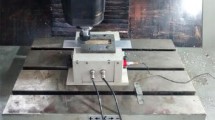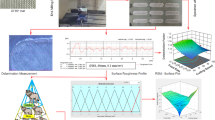Abstract
Glass fibre reinforced plastic (GFRP) composites are an economic alternative to engineering materials because of their superior properties. Some damages on the surface occur due to their complex cutting mechanics in cutting process. Minimisation of the damages is fairly important in terms of product quality. In this study, a GFRP composite material was milled to experimentally minimise the damages on the machined surfaces, using two, three and four flute end mills at different combinations of cutting parameters. Experimental results showed that the damage factor increased with increasing cutting speed and feed rate, on the other hand, it was found that the damage factor decreased with increasing depth of cut and number of the flutes. In addition, analysis of variance (ANOVA) results clearly revealed that the feed rate was the most influential parameter affecting the damage factor in end milling of GFRP composites. Also, in present study, Artificial Neural Network (ANN) models with five learning algorithms were used in predicting the damage factor to reduce number of expensive and time-consuming experiments. The highest performance was obtained by 4-10-1 network structure with LM learning algorithm. ANN was notably successful in predicting the damage factor due to higher R2 and lower RMSE and MEP.













Similar content being viewed by others
References
Gaitonde, V.N., Karnik, S.R., Campos Rubio, J., Esteves Correia, A., Abrão, A.M., Paulo Davim, J.: A study aimed at minimizing delamination during drilling of CFRP composites. J. Compos. Mater. 45, 2359–2368 (2011)
Azmi, A.I., Lin, R.J.T., Bhattacharyya, D.: Machinability study of glass fibre-reinforced polymer composites during end milling. Int. J. Adv. Manuf. Technol. (2012). doi:10.1007/s00170-012-4006-6
Davim, J.P., Reis, P., Antonio, C.C.: A study on milling of glass fiber reinforced plastics manufactured by hand-lay up using statistical analysis (ANOVA). Compos. Struct. 64, 493–500 (2004)
Davim, J.P., Reis, P.: Damage and dimensional precision on milling carbon fiber-reinforced plastics using design experiments. J. Mater. Process. Technol. 160, 160–167 (2005)
Rubio, J.C., Abroa, A.M., Correia, A.E., Davim, J.P.: Effect of high speed in the drilling of glass fiber reinforced plastic: Evaluation of the delamination factor. Int. J. Mach. Tools. Manuf. 48, 715–720 (2008)
Capello, E.: Work piece dam** and its effect on delamination damage in drilling thin composite laminates. J. Mater. Process. Technol. 148, 186–195 (2004)
Göloglu, C., Arslan, Y.: Zigzag machining surface roughness modelling using evolutionary approach. J. Intell. Manuf. 20, 203–210 (2009)
Fernandez-Abia, A.I., Barreiro, J., Lopez de Lacalle, L.N., Martinez, S.: Effect of very high cutting speeds on shearing, cutting forces and roughness in dry turning of austenitic stainless steels. Int. J. Adv. Manuf. Technol. 57, 61–71 (2011)
Senthil Kumar, K.L., Sivasubramanian, R.: Modeling of metal removal rate in machining of aluminum matrix composite using artificial neural network. J. Compos. Mater. 45, 2309–2316 (2011)
Bhat, C., Bhat, M.R., Murthy, C.R.L.: Characterization of failure modes in CFRP composites-An ANN approach. J. Compos. Mater. 42(3), 257–276 (2008)
De Albuquerque, V.H.C., Tavares, J.M.R.S., Durao, L.M.P.: Evaluation of delamination damage on composite plates using an artificial neural network for the radiographic image analysis. J. Compos. Mater. 44(9), 1139–1159 (2009)
Karnik, S.R., Gaitonde, V.N., Campos Rubio, J., Esteves Correia, A., Abrão, A.M., Paulo Davim, J.: Delamination analysis in high speed drilling of carbon fiber reinforced plastics (CFRP) using artificial neural network model. Mater. Des. 29, 1768–1776 (2008)
Al-Haik, M.S., Hussaini, M.Y., Garmestani, H.: Prediction of nonlinear viscoelastic behavior of polymeric composites using an artificial neural network. Int. J. Plast. 22, 1367–1392 (2006)
Fernández-Fdz, D., López-Puente, J., Zaera, R.: Prediction of the behaviour of CFRPs against high-velocity impact of solids employing an artificial neural network methodology. Compos. Part A 39, 989–996 (2008)
Chen, X., **e, H., Chen, H., Zhang, F.: Optimization for CFRP pultrusion process based on genetic algorithm-neural network. Int. J. Mater. Form. 3(Suppl 2), 1391–1399 (2010)
Chakraborty, D.: Artificial neural network based delamination prediction in laminated composites. Mater. Des. 26, 1–7 (2005)
Altinkok, N., Koker, R.: Modelling of the prediction of tensile and density properties in particle reinforced metal matrix composites by using neural networks. Mater. Des. 27, 625–631 (2006)
Yang, Y.K., Yang, R.T., Tzeng, C.J.: Optimization of mechanical characteristics of short glass fiber and polytetrafluoroethylene reinforced polycarbonate composites using the neural network approach. Expert Syst. Appl. 39, 3783–3792 (2012)
LiuJie, X., Davim, J.P., Cardoso, R.: Prediction on tribological behaviour of composite PEEK-CF30 using artificial neural networks. J. Mater. Process. Technol. 189, 374–378 (2007)
Naderpour, H., Kheyroddin, A., Ghodrati Amiri, G., Hoseini Vaez, S.R.: Estimating the behavior of FRP-strengthened RC structural members using artificial neural networks. Procedia Eng. 14, 3183–3190 (2011)
El-Mounayri, H., Kishawy, H., Briceno, J.: Optimization of CNC ball end milling: a neural network-based model. J. Mater. Process. Technol. 166, 50–62 (2005)
Aykut, S., Golcu, M., Semiz, S., Ergur, H.S.: Modeling of cutting forces as function of cutting parameters for face milling of satellite 6 using an artificial neural network. J. Mater. Process. Technol. 190, 199–203 (2007)
Cay, Y., Cicek, A., Kara, F., Sagiroglu, S.: Prediction of engine performance for an alternative fuel using artificial neural network. Appl. Therm. Eng. 37, 217–225 (2012)
Huang, B.P., Chen, J.C., Ye, L.: Artificial-neural-networks-based surface roughness Pokayoke system for end-milling operations. Neurocomputing 71, 544–549 (2008)
Nasiri, M.R., Mahjoob, M.J., Aghakasiri, A.: Damage detection in a composite plate using modal analysis and artificial intelligence. Appl. Compos. Mater. 18, 513–520 (2011)
Al-Assadi, M., El Kadi, H.A., Deiab, I.M.: Using artificial neural networks to predict the fatigue life of different composite materials including the stress ratio effect. Appl. Compos. Mater. 18, 297–309 (2011)
Al-Assadi, M., El Kadi, H., Deiab, I.M.: Predicting the fatigue life of different composite materials using artificial neural networks. Appl. Compos. Mater. 17, 1–14 (2010)
Sayin, C., Ertunc, H.M., Hosoz, M., Kilicaslan, I., Canakci, M.: Performance and exhaust emissions of a gasoline engine using artificial neural network. Appl. Therm. Eng. 27, 46–54 (2007)
Turan, M.: The high velocity impact damage in layered composite materials. Eng. Mech. 48(575), 1–8 (2000)
Razfar, M.R., Zanjani Zadeh, M.R.: Optimum damage and surface roughness prediction in end milling glass fibre-reinforced plastics, using neural network and genetic algorithm. Proc. Inst. Mech. Eng. Part B: J. Eng. Manuf. 223, 653–664 (2009)
Liu, D.F., Tang, Y.J., Cong, W.L.: A review of mechanical drilling for composite laminates. Compos. Struct. 94, 1265–1279 (2012)
Author information
Authors and Affiliations
Corresponding author
Rights and permissions
About this article
Cite this article
Erkan, Ö., Işık, B., Çiçek, A. et al. Prediction of Damage Factor in end Milling of Glass Fibre Reinforced Plastic Composites Using Artificial Neural Network. Appl Compos Mater 20, 517–536 (2013). https://doi.org/10.1007/s10443-012-9286-3
Received:
Accepted:
Published:
Issue Date:
DOI: https://doi.org/10.1007/s10443-012-9286-3




